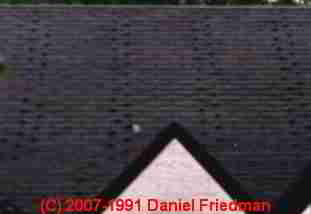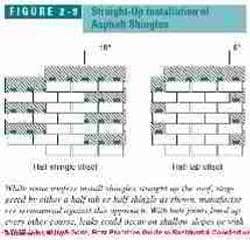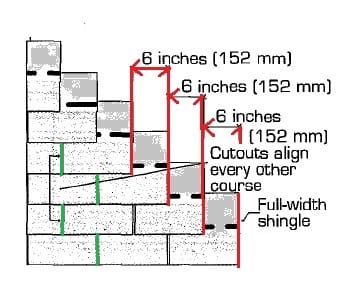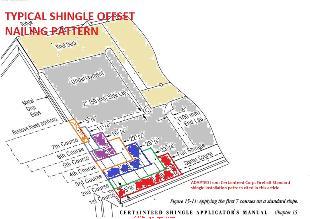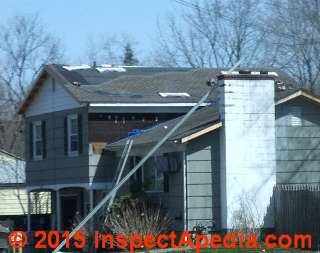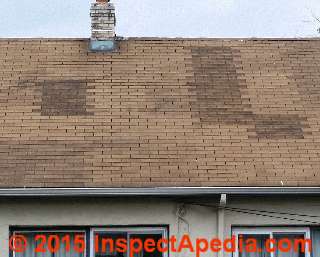 Asphalt Shingles Nailed in a Ladder Pattern
Asphalt Shingles Nailed in a Ladder Pattern
Shingle Racking Nailing Patterns
- POST a QUESTION or COMMENT about the pros and cons of installing roof shingles in a ladder pattern
Definition & effects of asphalt shingle laddering or ladder pattern installation. This article series defines shingle laddering - an installation pattern, and it explains how to identify & evaluate shingles installed in this "ladder pattern".
The information here describes the various sorts of roof leak, wear, and cosmetic issues caused by shingle laddering as an example of something a bit less than the "best" roof installation workmanship. These shingle laddering defects occur on both organic-mat and fiberglass-mat asphalt roof shingles.
Our page top photo shows an asphalt roof whose shingles were installed in the ladder pattern working up the roof rather than staggering shingle courses. The darker shingles mark areas of early roof shingle granule loss - a separate issue - whose resulting change in colour makes the ladder shingle pattern quite apparent.
InspectAPedia tolerates no conflicts of interest. We have no relationship with advertisers, products, or services discussed at this website.
- Daniel Friedman, Publisher/Editor/Author - See WHO ARE WE?
Laddering vs stair-stepping vs proper staggering of of roof shingle courses
The photo just above shows a sloppy "ladder pattern" installation of strip-type asphalt shingles.
While opinions (and expertise) vary among roofers, this ladder pattern shingle application may not be as durable a roof installation as one which staggered the shingle offsets more than a single six inches (or in this case only 3") left and right with each shingle course.
Our page top photograph of shingle laddering also illustrates granule loss probably traced to specific bundles of shingles that were defective.
See GRANULE LOSS from SHINGLES for more about that separate problem.
The laddered shingle nailing approach, not recommended by roofing manufacturers, permits the roofer to work right up the roof from eaves to ridge, without having to move beyond reach to left or right - an approach that is appealing if the roofer is working from roof jacks or other scaffolding that s/he does not want to keep relocating.
The second photograph, below, of fishmouthed asphalt shingles in a roof shingle ladder-nailing pattern at above-right right is courtesy of ASHI home inspector Carl Gerosa, New Rochelle, NY.
Definition of Laddering, Racking, Stair-Stepping, & Staggered Roof Shingle Courses
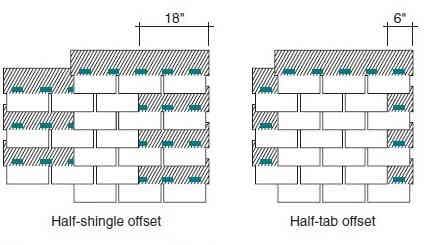 Definition of Laddered roof shingles - Shingle Racking
Definition of Laddered roof shingles - Shingle Racking
When shingles are installed on a roof using the "ladder" pattern or method, the roofer nails shingles straight up the roof, leaving the left or right shingle tab un-nailed so that when the roofer begins the next vertical assault on the roofing job he can interweave successive courses of those shingles into the ones already nailed.
Some sources refer to this as shingle racking - a synonym for shingle laddering.
[Click to enlarge any image].
The sketch of shingle laddering patterns shown above is adapted from Best Practices Guide to Residential Construction and discussed further below.
Shingle Laddering is Not Recommended
As reported in Best Practices Guide to Residential Construction (Steve Bliss, J Wiley & Sons) :
For ease of installation some roofers install shingles straight up the roof, staggering shingles 6 inches or 18 inches back and forth (Figure 2-9).
Since this lines up the shingle butt joints every other course, this is considered a less watertight roof and may leak.
Note: there is an important difference between vertical alignment of the shingle tab cutouts (a cosmetic effect described above), and the vertical alignment of shingle butt joints (the abutment of two individual shingles).
Vertically-aligned shingle butt joints that appear separated by just one shingle course are more likely to leak,especially in heavy or wind-blown rain storms.
Watch out: Installing roof shingles in a ladder pattern is not recommended by any roofing manufacturers.
Manufacturers also claim that shingle color patterns may create splotches or stripes if laid this way.
Technical Objections to Shingle Racking / Laddering
The principal objection to shingle racking or shingle laddering is that shingles are less likely to be properly-nailed. That's because when installing the next-parallel up-roof laddered group of shingles nails have been left-out of the ends of the previously-nailed ladder and are not likely to be added.
A second objection to shingle laddering or racking is that the extra peeling-back or lifting of the shingle ends to install the next ladder-group can cause excessive shingle bending, weakening or even stress-cracking the end of the shingle and shortening the life of the roof.
A third, and in our opinion cosmetic-only issue with shingle racking or laddering is that shingles from successive bundles, laddered up the roof, will often not blend correctly - you'll see rectangular patterns of shingles of different colors on the roof surfacce.
Ultimately shingle nailing defects, cracks, weaknesses, or wind damage mean roof leaks or shorter roof life.
The stair-step method assures proper shingle nailling. Failing to properly nail shingles invites wind damage and roof leaks.
While you won't find an outright prohibition of shingle laddering and racking in typical building codes & standards or HUD/FHA guidelines, the objections to shingle racking are outlined in various roofing manufacturer documents we cite throughout this article including:
- PRO FIELD GUIDE for STEEP SLOPE ROOFS, GAF [PDF] (2015), retrieved 2018/02/17, original source: http://www.buildsite.com/pdf/gaf2/GAF-Steep-Slope-Pro-Field-Guide-Installation-Instructions-1224183.pdf
Roof Shingle Manufacturer Policy on Shingle Racking / Laddering
Some roofing manufacturers state that they will accept shingle racking or shingle laddering for conventional three-tab roof shingle installations but emphasize that this is not a preferred method":
Racking… is when shingles are installed straight up the roof rather than being installed using the traditional stair step method.
Does GAF Approve Of The Racking Method? Three Tab Shingles… are acceptable, but it is not the preferred method of installation because of the possible installation problems and damage if proper precautions are not followed.
All other shingles (laminated or designer shingles)… Never.
The application method and specific offsets shown in the application instructions for each type of shingle must be followed to achieve the best appearance, good wind performance, and to avoid damage to the shingles from over-bending these heavy shingles during application. - source:
- GAF, TECHNICAL ADVISORY BULLETIN: Racking of Shingles [PDF] (2014) GAF Corporation, 1 Campus Drive Parsippany, NJ 07054 USA, Website: www.gaf.com retrieved 2018/02/17, original source: https://www.gaf.com/Warranties_ Technical_Documents/Steep_Slope_Technical_Advisory_ Bulletins/English_Bulletins/Racking_ Shingles_Steep_Slope_Technical_Point_TAB_R_2011_123.pdf
(Forgetting to go back and add the missing nails is a common laddered-roof defect as Skees elaborates below. )
Examples of Damage at a Racked / Laddered Roof Shingle Installation
On laddered asphalt shingle roofs, particularly older ones, you may notice that the pattern of fishmouth occurrence on an asphalt shingle roof follows a fairly regular or stair-stepped pattern, or it may follow a regular "ladder" like pattern up the roof such as is shown in these photographs.
Or as illustrated in the photo just above and in our page top photograph as well, shingles installed using the laddering pattern may become apparent as the roof ages or wears.
That's because the fishmouthing is occurring at the butt joints of the shingles where more moisture is passing out of the roof structure into the back side of the shingle above each butt joint.
More examples of the effects of racking shingles are
at LADDERED SHINGLE FAILURES & WEAR
Definition of stair-stepped roof shingle pattern:
The phrase stair-stepped shingles is usually synonymous with ladder roof shingle patterns
Definition of staggered roof shingle course nailing patterns: 4", 5" or 6" shingle course stagger nailing
Shingles are nailed to the roof deck such that each successive shingle course is offset 4", 5", 6" or in some instructions 7" thus distributing the butt joints over a wider horizontal area.
Offsetting successive shingle courses is a recommended roofing practice by virtually all shingle manufacturers.
The sketch above illustrates a six-inch stagger or offset shingle nailing pattern. You can identify, even from the ground, the staggering pattern by noting that the shingle tab cutouts align every other course.
This is a 6-inch stagger pattern.
A four-inch shingle offset pattern [photo] will produce cutouts aligning over one another vertically every third course, while a five-inch shingle offset pattern will produce tab cutouts that align over one another every seventh course. Sketch adapted from Flickinger (2000)[1] [Click to enlarge any image]
You can thus determine the actual pattern in which the shingles were applied to the roof. "Laddering," while permitted by some manufacturers and standards, is a less workmanlike shingle installation and may result in a localized early wear area on a roof.
For laminated or some other shingle designs the offset trim between the shingle courses may be 5 5/8" as we show in this example (below) from CertainTeed Firehalt shingle installation instructiont cited below.
[Click to enlarge any image]
Source & Authority:
- APPLICATION INSTRUCTIONS: LAMINATED SHINGLES [PDF] Certainteed Shingle Appolicator's Manual Supplement, retrieved 2018/02/17, original source: https://www.certainteed.com/resources/FirehaltInstall.pdf
Watch out: Ladder-pattern shingle application shows that the roofer liked to work up the roof from one position for as long as possible before moving. Shingles installed in this pattern may be more prone to roof leakage.
Below on a re-roof job in New York you can see, even from a distance, that the roofer is applying the roof shingles in a staggered, not a ladderd, pattern.
A Forensic Engineer's Comments on Shingle Laddering and Asphalt Roof Shingle Wind Damage
Nail Omissions - leaving out some nails - is at fault in laddered shingle blow-offs
James A. Skees, PE
On the photo of the laddering problem submitted by Carl Gerosa of New Rochelle, NY:
I have found that the loose corners are most often associated with the installer neglecting to place the nails at the ends of the shingles when installing the subsequent rows.
It is not necessarily the result of installing the shingles in a straight line up the roof. The same problem will occur diagonally when the nails are neglected (the common term is "three-nailing"). If the nails are all in the right place, the corners generally stay down either way.
Also see Mr. Skees' comments about nailing errors & asphalt shingle cellophane strip removal
...
Continue reading at LADDERED SHINGLE FAILURES & WEAR or select a topic from the closely-related articles below, or see the complete ARTICLE INDEX.
Or see
Recommended Articles
Suggested citation for this web page
LADDERING vs STAIR STEPPING SHINGLES at InspectApedia.com - online encyclopedia of building & environmental inspection, testing, diagnosis, repair, & problem prevention advice.
Or see this
INDEX to RELATED ARTICLES: ARTICLE INDEX to BUILDING ROOFING
Or use the SEARCH BOX found below to Ask a Question or Search InspectApedia
Ask a Question or Search InspectApedia
Try the search box just below, or if you prefer, post a question or comment in the Comments box below and we will respond promptly.
Search the InspectApedia website
Note: appearance of your Comment below may be delayed: if your comment contains an image, photograph, web link, or text that looks to the software as if it might be a web link, your posting will appear after it has been approved by a moderator. Apologies for the delay.
Only one image can be added per comment but you can post as many comments, and therefore images, as you like.
You will not receive a notification when a response to your question has been posted.
Please bookmark this page to make it easy for you to check back for our response.
IF above you see "Comment Form is loading comments..." then COMMENT BOX - countable.ca / bawkbox.com IS NOT WORKING.
In any case you are welcome to send an email directly to us at InspectApedia.com at editor@inspectApedia.com
We'll reply to you directly. Please help us help you by noting, in your email, the URL of the InspectApedia page where you wanted to comment.
Citations & References
In addition to any citations in the article above, a full list is available on request.
- [1] Dave Flickinger, "Offset Patterns for Asphalt Shingles", Professional Roofing, National Roofing Contractor's Association (NRCA), May 2000. Professional Roofing Magazine, 10255 W. Higgins Rd., Suite 600, Rosemont IL 60018, Tel: 847-299-1183.
- Carl Gerosa, Target Inspection Consultants, Inc., New Rochelle, NY 10804, Tel: 914-833-2900 / 914-834-7494, New York Home Inspectors License Number: NY 1600005625/CT 20 is a certified ASHI inspector and a member of CAHI, the Connecticut Association of Home Inspectors. Mr. Gerosa provides home inspections of Single Family Homes, Radon Testing, Wood Destroying Organisms. Email: targetinspection@aol.com
- Thanks to James A. Skees, PE, President and Sr. Forensic Engineer, OnTheRock Engineering, LLC, 604 W. Jefferson Street, LaGrange, KY 40031
502-225-6203 FAX 225-6204, for commenting on the roof cellophane strip problem, on wind damage to roof shingles, shingle blow off, improper shingle nailing, and roof shingle laddering underlying defects, August 2010. Mr. Skees is a forensic engineer who works for insurance companies. Mr. Skees can also be reached by email at jimskees@ontherockeng.com
The company has published online a sample Tornado Report
"Residential Wind Damage Evaluation", Wind Damage Sample, found at http://www.ontherockeng.com/Sample%20Tornado%20Report.pdf - Our recommended books about building & mechanical systems design, inspection, problem diagnosis, and repair, and about indoor environment and IAQ testing, diagnosis, and cleanup are at the InspectAPedia Bookstore. Also see our Book Reviews - InspectAPedia.
- Architectural elements: the technological revolution: Galvanized iron roof plates and corrugated sheets; cast iron facades, columns, door and window caps, ... (American historical catalog collection), Diana S Waite, available used out of Amazon.
- Asphalt Roofing Residential Manual from ARMA the Asphalt Roofing Manufacturers Association Website https://www.asphaltroofing.org/product/residential-asphalt-roofing-manual/ ,
- Building Pathology, Deterioration, Diagnostics, and Intervention, Samuel Y. Harris, P.E., AIA, Esq., ISBN 0-471-33172-4, John Wiley & Sons, 2001 [General building science-DF] ISBN-10: 0471331724 ISBN-13: 978-0471331728
- Building Pathology: Principles and Practice, David Watt, Wiley-Blackwell; 2 edition (March 7, 2008) ISBN-10: 1405161035 ISBN-13: 978-1405161039
- Built-Up Roof Systems, Manual C.W. Griffin, Mcgraw-Hill (Tx); 2nd edition (July 1982), ISBN-10: 0070247838, ISBN-13: 978-0070247833
- Concrete Folded Plate Roofs, C. Wilby PhD BSc CEng FICE FIStructE (Author), Butterworth-Heinemann, 1998, ISBN-10: 0340662662, ISBN-13: 978-0340662663
- Concrete Shell Roofs, C. Wilby PhD BSc CEng FICE FIStructE (Author),
- Concrete Dome Roofs (Longman Concrete Design and Construction Series),
- Concrete Roofing Tile, History of the, Batsford, 1959, AISN B000HLLOUC (availble used)
- Copper Roofing, by CDA
- Copper Roofing, Master specifications for copper roofing and sheet metal work in building construction: Institutional, commercial, industrial, I.E. Anderson, 1961 (hard to find)
- Corrugated Iron, Building on the Frontier, Simon Holloway
- Green Roof Plants: A Resource and Planting Guide, Edmund C. Snodgrass, Lucie L. Snodgrass, Timber Press, Incorporated, 2006, ISBN-10: 0881927872, ISBN-13: 978-0881927870. The text covers moisture needs, heat tolerance, hardiness, bloom color, foliage characteristics, and height of 350 species and cultivars.
- Green Roof Construction and Maintenance, Kelley Luckett, McGraw-Hill Professional, 2009, ISBN-10: 007160880X, ISBN-13: 978-0071608800, quoting: Key questions to ask at each stage of the green building process Tested tips and techniques for successful structural design Construction methods for new and existing buildings Information on insulation, drainage, detailing, irrigation, and plant selection Details on optimal soil formulation Illustrations featuring various stages of construction Best practices for green roof maintenance A survey of environmental benefits, including evapo-transpiration, storm-water management, habitat restoration, and improvement of air quality Tips on the LEED design and certification process Considerations for assessing return on investment Color photographs of successfully installed green roofs Useful checklists, tables, and charts
- Handbook of Building Crafts in Conservation, Jack Bower, Ed., Van Nostrand Reinhold Company, NY 1981 ISBN 0-442-2135-3 Library of Congress Catalog Card Nr. 81-50643.
- Historic Preservation Technology: A Primer, Robert A. Young, Wiley (March 21, 2008) ISBN-10: 0471788368 ISBN-13: 978-0471788362
- Low Slope Roofing, Manual of, 4th Ed., C.W. Griffin, Richard Fricklas,
McGraw-Hill Professional; 4 edition, 2006, ISBN-10: 007145828X, ISBN-13: 978-0071458283
- Roof failure causes in depth (and specific methods for avoiding them)
- Roof design fundamentals and flourishes, based on voluminous industry research and experience
- New technologies and materials -- using them safely and correctly
- Comprehensive coverage of all major roofing systems pecifications, inspection, and maintenance tools for roofing work
- In addition to citations & references found in this article, see the research citations given at the end of the related articles found at our suggested
CONTINUE READING or RECOMMENDED ARTICLES.
- Carson, Dunlop & Associates Ltd., 120 Carlton Street Suite 407, Toronto ON M5A 4K2. Tel: (416) 964-9415 1-800-268-7070 Email: info@carsondunlop.com. Alan Carson is a past president of ASHI, the American Society of Home Inspectors.
Thanks to Alan Carson and Bob Dunlop, for permission for InspectAPedia to use text excerpts from The HOME REFERENCE BOOK - the Encyclopedia of Homes and to use illustrations from The ILLUSTRATED HOME .
Carson Dunlop Associates provides extensive home inspection education and report writing material. In gratitude we provide links to tsome Carson Dunlop Associates products and services.



